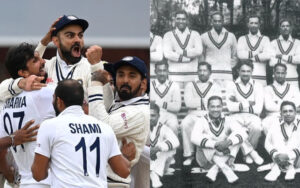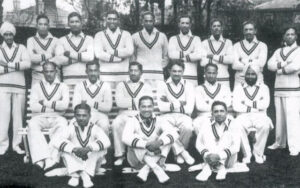
Now that the itinerary for India’s tour to England in 2025 has been announced and we are playing a June Test after a gap of 29 years, it is time to look back on the first tour 92 years ago, when a young and unfancied Indian side traveled to England for the first time.
The Times, London on March 1, 1932, one-and-a-half months before the Indians embarked on their tour of England, published the following report:
“The game gown on…The Delhi police may be having three sharp rounds with a rioting crowd in the Chandni Chowk, the crowded bazaar of the old city, but a mile or two away on the club ground set in the gardens that 400 years ago Shah Jehan built for his princess, a Roshanara side will be playing the Punjab Wanderers or an Army team from New Cantonments will be fielding in the white sunlight.…
Here is the team for England:
The Maharaja of Patiala, Captain (eventually withdrew in favour of the Maharaja of Porbander), K. S. Ghanshyamsinhji (Kathiawar), Vice Captain, Amar Singh (Jamnagar), S.M.H Colah (Bombay), Ghulam Mohammed (Ahmedabad), Joginder Singh (Punjab), B.E. Kapadia (Bombay), Lal Singh (Kuala Lumpur), N.D. Marshall (Bombay), J. Naoomal (Karachi), J.G. Navle (Gwalior), C.K. Nayudu (Indore), Nazir Ali (Patiala), S. M. Nissar (Punjab), P.E. Palia (Mysore), S Godambe (Bombay), Wazir Ali (Bhopal).
It will be seen that the team is composed entirely of Indians; the question of selecting Englishmen playing in India did not arise.”
And soon after the Indian team arrived in England on April 13, 1932, the Evening Standard commented on the socio-political significance of the tour:
“No politics, no caste, just cricket. This is the unofficial slogan of the cricket team that has come from India after a lapse of 21 years to try its strength against England and the first class counties.
For the Latest Sports News: Click Here

There has never been such a team of contrasts meeting on the common footing of cricket. The 18 players speak eight to ten languages among them; they belong to four or five different castes.
Caste demands that the Hindus do not eat beef or veal, and that the Mohammedans avoid pork, bacon and ham. So to prevent any difficulties at meal times the order has gone forth that these things must not appear on any menu during the tour. Instead the men will eat mutton, chicken and fish.
The team contains six Hindus, five Mohammedans, four Parsees and two Sikhs. The Mohammedans forswear alcohol by religion and most of the others do so by choice. The Sikhs, who will play cricket in turbans, are similarly denied smoking…”
The Indians played their first tour match against TG Trott’s XI at Pelsham Farm, Pearmarsh near Rye on April 29, 1932. Interestingly, playing against the Indian team in this match was Duleepsinhji. While the Indians acquitted themselves well, with Lall Singh, the Sikh from Malaya leading the way, it was on May 22, 1932 in the match against the MCC that the world got a glimpse of what India’s first homegrown legend, CK Nayudu, was capable of doing. Nayudu, Wisden Cricketer of the Year in 1933, smashed the first Indian century of the tour in style. The Star’s headline on May 22, 1932 summed it all up: “The Hindu Bradman in Form at Lords”. The Observer was equally eloquent: “A brilliant not out innings of 116 by C.K. Nayudu was the feature of the first day’s play between All-India and the MCC.”
However, it was in the first and only Test match at Lord’s that the Indians shocked the English in the first half-hour itself. The MCC was reduced to a dismal 19-3 by some excellent Indian bowling and fielding. Wrote The Birmingham Post: “It was an extraordinary start to the match. Sutcliffe and Holmes, Yorkshire’s record smashing opening pair, united in a similar manner under the banner of England, went out full of cool confidence…But the first ball of Nissar’s second over…was an in-swinger and Sutcliffe, playing with the edge instead of the middle of the bat, diverted it into the wicket—and one of England’s greatest batsmen was out…The disappointment was redoubled and revived when the last ball of the same over, a delivery perfect in flight, length and pace, sent Holmes’ off stump spinning through the air, while the batsman was only half way through the stroke…Woolley and Hammond were now together…
When he (Woolley) had got nine in 20 minutes, he played a ball from Nissar to a point between short leg and mid-on. The stroke was worth a comfortable single and no more, but for some extraordinary reason an attempt was made to secure two runs. The fielder, the blue turbaned Lall Singh, threw in rather wildly, but even so the wicketkeeper had time to gather it and remove the bails while Woolley was still several feet from home. The wicket was thrown away by wild calling, and three men were out for 19…”

Though India eventually lost the match by 158 runs, the courage and grit shown at Lord’s clearly conveyed to the world that the Indians, in little time, would carve out a niche in the world of cricket.
Today, when Rohit Sharma’s team travels to England in 2025, it will be a series that will be watched the world over and make a major contribution to the ECB’s coffers. The truth is India now travels to the UK as the team that controls world cricket’s purse and is the most sought after.
Also Read: PSC’s decision on Anwar Ali expected next week, threat of ban looms




